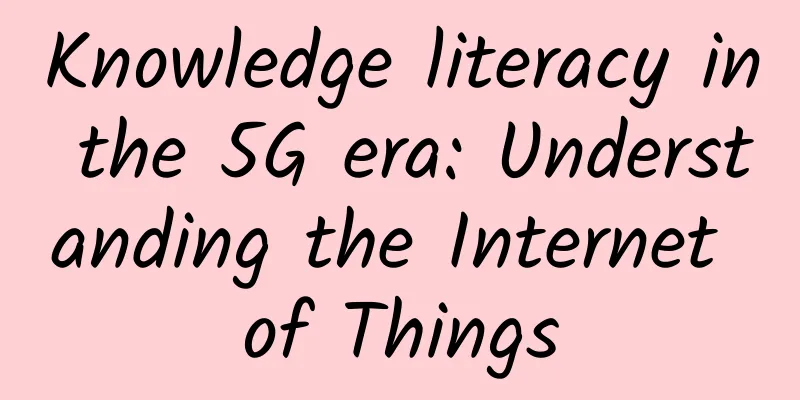Knowledge literacy in the 5G era: Understanding the Internet of Things

|
What is IoT The Internet of Things (IoT) is abbreviated as IOT, which means the Internet of Things connected to each other. It is a network that extends and expands on the basis of the Internet to enable communication between things. Simply put, all the objects around us have a chip that can be connected to the Internet, and objects can exchange information with each other. The Internet of Things is another wave of information industry after computers, the Internet, and mobile Internet. The Internet of Things is generally a wireless network. Through the physical network, it is possible to use a central computer to centrally manage and control devices and machines. At the same time, it is also possible to control home devices with mobile phones (smart home direction), etc. What is the background of the birth of the Internet of Things? The Internet of Things is the natural choice of the times and meets the development needs of human society. Since the end of the 20th century, the global economy has continued to be sluggish, and there is an urgent need for the emergence of an emerging technology to promote productivity changes and become a new engine for economic growth. In the late 20th century, the concepts of smart buildings and smart homes emerged in the United States and Europe. In 1995, Bill Gates made a detailed description of the application of IoT technology in home scenarios in his book "The Road Ahead", which gave people a preliminary understanding of IoT applications. In 1999, MIT's Auto-ID Lab made the feasibility of IoT technology concrete. The name of the Internet of Things came from the report "The Internet of Things" released by the International Telecommunication Union in 2005; By 2009, IBM's three-step physical network strategy had received widespread response from industry and academia around the world. China began to attach great importance to the Internet of Things technology in 2009 What are the architecture and components of the Internet of Things? The Internet of Things mainly includes four levels: perception and control layer, network layer, and application layer. Internet of Things IoT Network Architecture Physical Network Communication Protocol It is necessary to understand this because traditional communication protocols such as the Http protocol are large in content and are not suitable for information dissemination under the Internet of Things. Currently there are: MQTT protocol, CoAP protocol, AMQP protocol, etc. Current Applications of IoT Smart manufacturing, smart robots, smart homes, smart cities, smart transportation, autonomous driving, etc. |
<<: Network Automation: The Core Competitiveness of Operators in the 5G Era
>>: Viewpoint sharing: Why smart cities need powerful 5G networks?
Recommend
RackNerd adds a new user self-service IP change function, starting from $10.18/year in multiple data centers in San Jose/Los Angeles/Seattle
RackNerd has officially added a self-service IPv4...
What the three major operators fear the most has come, and packages say goodbye to the "routine" era!
With the continuous development of science and te...
spinservers: 100M-1Gbps unlimited traffic servers starting from $118/month, Dallas/Silicon Valley data centers available
spinservers is a site under Majestic Hosting Solu...
Everything You Should Know About Computer Networks for Your Job Interview
"Are you ready for the interview?" &quo...
GSMA: Global 5G connections will reach 1.8 billion by 2025
According to a new study from GSMA, global 5G con...
How cloud services enable a 5G-driven future
As high-speed cellular networks become mainstream...
Mobile 2G 3G 4G 5G Communication Base Station Architecture Evolution
Mobile communication systems have evolved from th...
How to find the causes of various network failures?
Network outages, freezes, unstable connections, a...
5G and Net Zero: Can the Two Overlap?
As COP27 wraps up this year’s agenda, a number of...
GSA: 5G has become a mainstream technology, and 5G FWA CPE shipments will account for 42% this year
According to a recent study conducted by the Glob...
Kuroit: £3/month-1GB/15G NVMe/1TB@10Gbps/Ashburner data center
Kuroit is currently promoting its Ashburn data ce...
Yecao Cloud: Hong Kong VPS annual payment starts from 168 yuan, Hong Kong dedicated server starts from 199 yuan/month, BGP or CN2 line
Yecaoyun is still offering promotions for Hong Ko...
Three-layer network model of Internet products
If you ask what is the biggest feature of Interne...
Viavi: Global 5G deployments to grow by more than 20% in 2021
Viavi Solutions Inc. released a new study on June...









